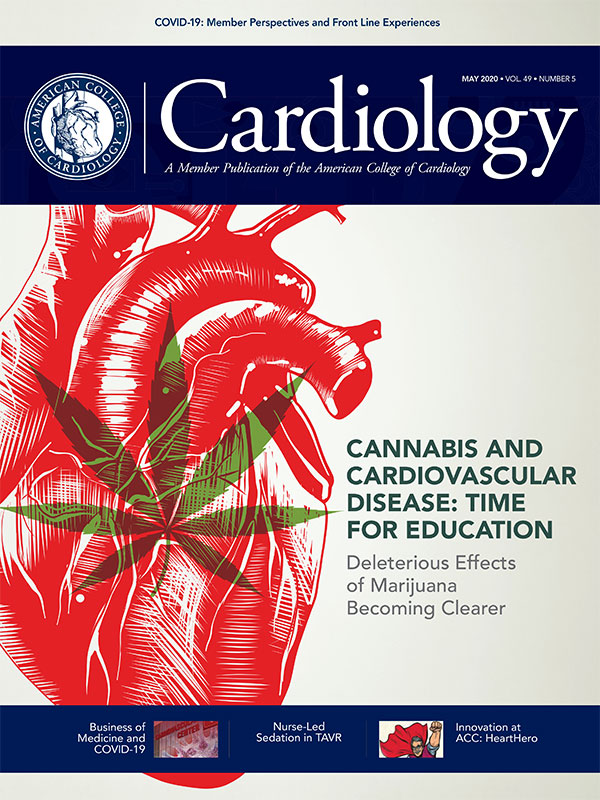Reinventing Cardiovascular Care in Two Weeks: An Industry Adapts to a Pandemic

Facing drastic declines in patient visits, procedures and revenue, the cardiovascular industry reinvented itself in a matter of weeks and is now delivering vital care to millions of patients across the U.S. through telemedicine and other innovative solutions.
An article published by MedAxiom details the importance community has played in the cardiovascular industry's ability to adapt and innovate, with administrators and clinicians coming together like never before to learn from each other, support each other, and advocate for resources and support.
As an industry, health care is celebrated for its rapid development of new clinical technologies, drugs and devices that have radically improved the trajectory of patient outcomes. Nowhere is this more true than in cardiovascular medicine.
Over the last 50 years, thanks to innovative advancements in procedures, devices, pharmacologic solutions and research, cardiovascular mortality in the U.S. has markedly declined.
The story is quite different when looking at the delivery of health care and the administration of the operations. Other than the addition of a computer, an exam room from 1980 would look very similar with the exam room of today and the patient journey has remained the same for decades.
Patients come to the doctor's office for visits or testing, they register, they wait in a room that bears the activity's name – hopefully with current magazines – and then they see their provider. This sequence would describe virtually all patient encounters over the past decades.
On the administrative side, the typical structure includes an executive team supported by, depending on the size of the organization, a cadre of directors and managers who execute on decisions and generally keep the trains running and on time.
Decisions within this structure are typically made at monthly meetings and, when involving any kind of financial investment, would require a formal business plan or other supporting documentation.
In larger organizations, the timeline to a "yes" or "no" can be measured in months and sometimes even years. Health care organizations proudly label this "fiscal discipline" and embrace it like a prized family heirloom.
Another tradition held tightly by the health care community has been the devotion to the fee-for-service payment system. While this model of payment spurred the clinical innovations cited above, it has also led to an unsustainable increase in overall health care spending that is jeopardizing the solvency of the country and disadvantaging the U.S. in a worldwide economy.
Granted, there is a strong element of self-preservation here as Medicare and nearly all the commercial and third-party payers remunerate providers on a per-unit basis. However, the industry has held onto this model – and rejected or resisted repeated attempts at reform – despite a mountain of evidence, both economic and convenience, to change. The lethargic adoption of telemedicine is a great example.
Enter a Worldwide Pandemic

As Americans rang in a new decade a novel virus first detected in China was just starting to be known to World Health Organization (WHO) leaders. By the end of January, the U.S. recorded its first coronavirus case in the state of Washington and President Donald J. Trump banned all foreign nationals from entering the U.S. if they had traveled to China within the previous two weeks.
In February, the WHO labeled coronavirus "COVID-19" and Italy locked down its entire 60 million residents. On March 11, the WHO declared COVID-19 a pandemic and President Trump banned entry into the U.S. from 26 European countries.
Just two days later the president declared a U.S. national emergency. Now the majority of Americans are in quarantine, the worldwide cases are approaching 3.6 million and there are close to 250,000 global deaths as of the article publication date.1 Predictions remain fluid, but most agree the world is still waiting on the peak of the pandemic.
The Italian experience demonstrates that one of the biggest threats of the COVID-19 pandemic is that clusters of sick patients can quickly overwhelm the health care system, where hospitals simply run out of beds or ventilators to treat the critically sick.
In these concentrated situations, providers can then become infected decimating caregiver ranks and exacerbating an already perilous situation. The U.S. has seen a growing number of examples of this in the states of Louisiana and Washington and in New York City and Detroit.
The impact to the cardiovascular community has been just as intense and rapid. While COVID-19 first entered the U.S. at the beginning of the year, until mid-March it was "business as usual" in the vast majority of health systems around the country. There were no reports of furloughed staff, no mass canceling of patient appointments or procedures, and no plans to radically change the care delivery model.
According to results of the Impact of COVID-19 on Cardiovascular Organizations Survey completed by MedAxiom members, within a breakneck two-week time period, the majority of cardiovascular programs around the country had seen or were implementing drastic reductions in care.
These data show that nearly all elective cases have been shuttered, almost 50% of groups have seen an office visit cancelation rate of 25-50% and almost 40% of groups have moved more than 75% of their formerly in-person office visits to remote visits.
In efforts to protect both providers and staff, hospital coverage has largely been centralized to physicians, pulling back utilization of advanced practice providers (APPs) and nurses, with much of the care being rendered without ever entering the patient's room. Programs have directed anyone who can possibly work remotely from home to do so. In many cases, jobs deemed nonessential have been furloughed.
According to the MedAxiom survey data, 50% of groups are predicting at least a 25% reduction in revenue during the first quarter of 2020, with about half this group predicting drops of 50-75%. When looking ahead to quarter two, nearly half of groups are predicting a 50-75% reduction in revenue for the quarter. Not surprisingly, these dire predictions magnify in the smaller programs.
Despite these precipitous drops in volumes, in the majority of health institutions the expense side of the ledger is tied up in fixed costs. Therefore, absent significant staff layoffs, this drop in volume – and thus revenue – will have a magnified impact on the bottom line.
While the MedAxiom survey data suggest programs are doing what they can to avoid staff furloughs in the near term, prolonged volume reductions will inevitably lead to staff layoffs.
In fact, more than 10% of cardiovascular leaders who participated in the survey are predicting to place 25-50% of their staff on unpaid leave in the next month, with another 7% predicting greater than 50% of staff will be sidelined. According to the survey data, the smaller programs are predicting to fair worse than the larger.
The Community Responds

Because COVID-19 makes it dangerous for people to gather in large groups, having patients travel to offices for visits or testing suddenly becomes problematic. At the same time, simply cutting off care for at-risk patients with cardiovascular disease is not only dangerous, but can literally be deadly. Thus, balancing the safety of both patients and the provider community is a delicate and imperfect art form.
As the cardiovascular community wrestled with this conundrum, the obvious choice for safely extending care quickly zeroed in on telemedicine. Unfortunately, the infrastructures around these technologies were not mature on March 1 requiring a rapid evolution or in some cases de novo creation. According to results of the MedAxiom Provider Compensation and Production Survey, in 2019 less than 5% of all cardiovascular patient visits were made using telemedicine.
As a result of the COVID-19 pandemic, telemedicine was rapidly adopted in a matter of weeks. Data from MedAxiom's Impact of COVID-19 on Cardiovascular Organizations Survey revealed that by March 30, over half of the groups (52.3%) were performing less than a quarter of their patient visits by face-to-face visits. In other words, 75% of encounters were by some form of remote or telemedicine means.
This pivot would be easy to take for granted, particularly since everyone is knee-deep in continued coronavirus emergencies and supply shortages, but it is nothing short of remarkable.
Additionally, it is certainly not the "standard operating procedure" for health care organizations from a change standpoint; there was no time for formal business plans, budgeting processes or the methodical march through decision matrixes.
All of this started before the Centers for Medicare and Medicaid Services (CMS) put out its first emergency declarations in March. Provider schedules were altered, staff were shuffled and clinical pathways were both changed and invented.
Certainly, the emergency orders, which have relaxed compliance rules and provided payment for previously noncompensated telemedicine visits, have hastened implementation, but the transition was already well under way.
It Takes a Community

How could an industry so historically resistant to change and proud of its fiscal discipline move so far so fast?
The main reason: community. Setting aside any competitive or proprietary concerns, organizations around the country – and the world – started sharing information with each other. Clinical science has been determined, aggregated and disseminated by the ACC through webinars for thousands of clinicians around the world.
Cardiovascular programs from both ends of the telemedicine evolution spectrum generously shared pathways, staff training and helpful technology tips learned on their respective journeys.
MedAxiom, an ACC Company and national cardiovascular membership organization, has hosted a series of webinars open to all organizations aimed at distilling the mountains of shared member wisdom into concise and useful standards and pathways.
Additionally, it has provided cardiovascular programs regular updates on the federal emergency orders, with practical guidance on the immoderately complex billing and coding requirements of CMS and other third-party payers.
While this kind of knowledge sharing is nothing new in the cardiovascular community, MedAxiom has seen traffic on its administrative listserv surge over 250% during March compared with previous months and nearly 300% on its physician listserv.
Attendance for MedAxiom webinars typically measured in hundreds of participants has regularly topped 1,000 during the pandemic. The community has lifted itself up with heartwarming stories of generosity and courage, shown under the intense pressure of an expanding pandemic.
This spirit is captured by Edward Fry, MD, FACC, from St. Vincent Health in Indiana:
"With respect to staff, we see them as not only the most vulnerable to this crisis but also critical to its recovery. They will represent the critical rate limiting step to rebooting our practices as we ramp back up.
As such, we are doing everything we can as a system as well as through the generosity of individuals to soften the impact and to retain staff in place. This includes encouraging staff to use PTO, reducing work hours rather than eliminating positions, redeployment to other needs within the hospital and health system, etc.
As individual physicians, we are creating a fund outside the health system to support care team partners at the low end of the pay scale (medical assistants, administrative assistants, techs, front office staff, etc.). We hope to distribute funds to help cover expenses (doing so in a way without tax implications for either party – harder than you might think).
Initially we are not including higher paid or salaried staff (APPs, RNs, management, higher paid technical staff), but will reassess each group as we go on. I have been impressed, but not surprised, by the unanimity of support among the physician community. All have recognized this human need."
The Legacy of the Pandemic

Even before the COVID-19 crisis, telemedicine was beginning, albeit grudgingly, to take on a more prominent role in the U.S. care delivery model. Particularly in very rural areas where physician availability is scarce, telemedicine has been employed with some success.
What has been learned through the rapid expansion of these electronic services due to the pandemic is that, under the right circumstances and with the appropriate patient populations: 1) telemedicine works well; 2) patients generally like the convenience of receiving routine care in their homes; and 3) providers have mostly found the experiences effective in delivering necessary care.
The need for continued use of telemedicine beyond the pandemic is also supported by the inefficiency and high cost of cardiovascular outreach. Putting cardiologists in cars for several hours a day to see a small number of patients – mostly routine follow-ups – is a scenario begging for a better way.
As the industry proves the utility of telemedicine for this segment of care, it is not much of a stretch to think it may become a permanent replacement or at least reduction to the current traveling outreach clinician.
Such a change would also extend scarce subspecialty resources like electrophysiologists, cardiac surgeons, heart failure physicians and now structural heart/valve specialists.
The conversion to telemedicine by the cardiovascular and overall health care community has been so swift and significant, it is hard to imagine that CMS could roll back the payment of these services entirely once the pandemic abates.
Should all or most of this reimbursement remain in place, the cardiovascular community will undoubtedly continue to utilize this in a significant way post coronavirus. Even if CMS pulls back funding, the safe bet is that telemedicine will not fall back to pre-COVID levels.
In addition, there has also been a significant amount of provider coverage changes. Physician groups have developed group-wide plans that make sense for their patients and their communities including, hospital coverage, physician to physician collaboration, shared decision-making on essential procedures and staffing support. Along with telemedicine, these changes are transforming cardiovascular care.
Conclusion

The ability of the cardiovascular community to quickly adapt under the extreme duress of a worldwide pandemic has been awe-inspiring and remarkable.
As witnessed through listserv posts and webinars, there have been gut-wrenching deliberations around staff and provider safety, difficult staff redeployment decisions and rapid acquisitions – or sometimes conscription – of technology.
Had this not occurred, patients needing critical care would have gone unseen and become more vulnerable; staff in larger numbers or more quickly would have had to be laid off; and more providers would have been exposed and then necessarily taken out of care delivery at a time when their communities need them most.
Despite the fast action of the cardiovascular community to shift care delivery to telemedicine, the pandemic will take a significant financial toll on providers and health care organizations, one that is likely to last well beyond the crisis itself.
Given health care's position as a leading employer in the U.S., these kinds of predictions are a dire harbinger of rough economic times ahead.
Beyond COVID-19 there have been and will continue to be myriad challenges menacing health care and cardiovascular organizations. Over the last few weeks the cardiovascular industry has proven that under extreme pressure it can adapt quickly.
That skillset will continue to be valuable and it is essential for health care leaders to hold on to an innovative spirit as they are currently dedicated to traditional business models. Adaptability will serve cardiovascular organizations well in the future – just as it has in response to the pandemic.
Reference
- World Health Organization. (May 6, 2020). Coronavirus disease (COVID-19) Pandemic. Available here.
Keywords: ACC Publications, Cardiology Magazine, COVID-19, Pandemics, Coronavirus, Coronavirus Infections, severe acute respiratory syndrome coronavirus 2, Quarantine, Fee-for-Service Plans, Insurance, Health, Reimbursement, Medicare, Ursidae, Caregivers, Pharmaceutical Preparations, Centers for Medicare and Medicaid Services, U.S., Health Expenditures, Critical Pathways, Emergencies, Solvents, Follow-Up Studies, Specialization, Cardiovascular Diseases
< Back to Listings

